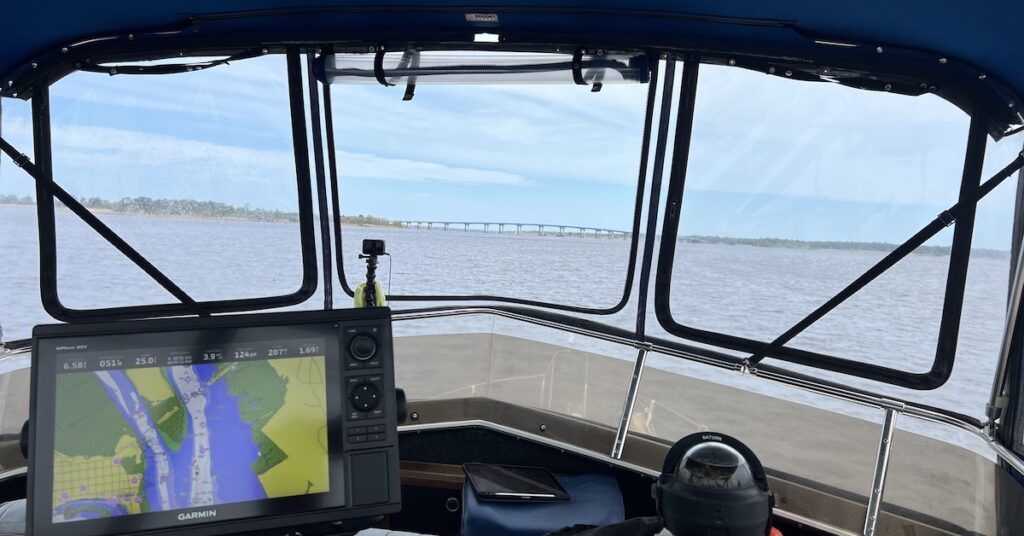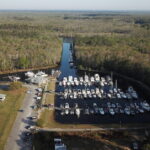April 2, 2022: We finally leave Georgetown and continue north.
In my previous blog post, I told the long story about our navigational equipment repairs, so I won’t repeat that here. It does explain why we spent so much time in Georgetown, SC, though, so if you skipped that, you might want to read it now.
At Hazzard Marina
Saturday morning started clear and beautiful with light winds. For the second time at Georgetown, I sent my drone up for some photos. I later sent a bunch of these to the marina management for their use, in part to thank them for their hospitality. (I really did like that marina!) It’s interesting to note that in order to fly my drone there I had to get authorization through the DJI App, which required a lot of tapping, clicking, and restarting. I’d done it earlier in the week, but that authorization was only good for 48 hours.

Aerial view of Hazzard Marina in Georgetown, SC.
Brian the Electrician showed up after 9, struggled with the system for a while, and concluded that the radar unit was bad. That could have meant sticking around in Georgetown until at least Tuesday when the replacement unit would have arrived and have been installed. Fortunately, Capt John was just as bored with Georgetown as I was and he made arrangements to meet Brian farther up the coast the following week to finish the job.
Brian left and Capt John left to return the rental car. I did some chores and neatened up the boat. Among those chores was chopping up onions, carrots, potatoes, and celery for that evening’s dinner: beef stew. Although Capt John usually just throws the raw ingredients into the crockpot and lets them cook all day, I dusted the beef with flour and browned it first. Then I added some water and beef bullion and a package of onion and mushroom soup mix for good measure. And a few of the tomatoes we’d bought more than a week ago in Charleston, which were starting to show their age. We set the pot atop the closed stovetop, plugged it into an inverter-powered outlet, and let it cook.
By 1 PM, we were pulling away from the dock with Susan (the dockhand) and another boater helping to push us away from the dock in the wind that had kicked up since that morning.
Hazzard to Wacca Wache
By the time we left Georgetown, the weather had changed. It was now overcast with high clouds, bright with a very cool wind. Up in the command bridge, with the front window rolled up, I had to wear a thick flannel jacket to keep warm
We came down into Winyah Bay, where the Sampit, Waccamaw, and Great Pee Dee Rivers converge before exiting into the Atlantic Ocean. We wanted the Waccamaw River, which was the easternmost channel. We slipped under the Lafayette Bridge there and headed almost due north, against a slow tidal current. The tide was still going out and the river’s current and outgoing tide would work against us.
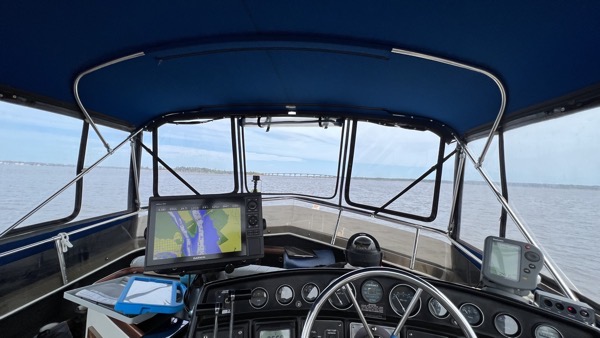
Here’s a wide angle view of the command bridge as we approached the Lafayette Bridge. You can see the new chartplotter and Capt John’s tablet (for backup) on the left.
Still, we moved along at our usual rate — around 6 knots, which was the best fuel economy speed for Carver 36’s thirsty engines. While we cruised along, Capt John fiddled around with the new chartplotter which, although a much newer model than he had, was still very similar in its feature set. We cruised through mostly empty land, with former rice fields off to port (northwest). There were a handful of long, narrow islands with the channel on one side and some Waterway Guide anchorages on the other. There were few boats on the channel; most of the ones we saw were large cruisers — larger than us — which passed politely or small recreational fishing boats with some hard core fishermen on board.
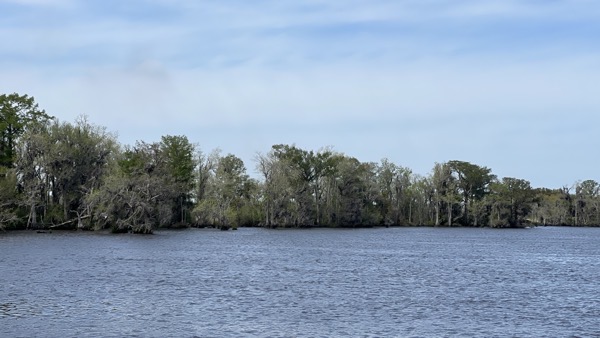
I shot this at Woodville Island (according to the data embedded in the photo). It’s typical of the scenery on the mainland side of the ICW here: trees growing right out of the water with old rice fields hidden behind them.
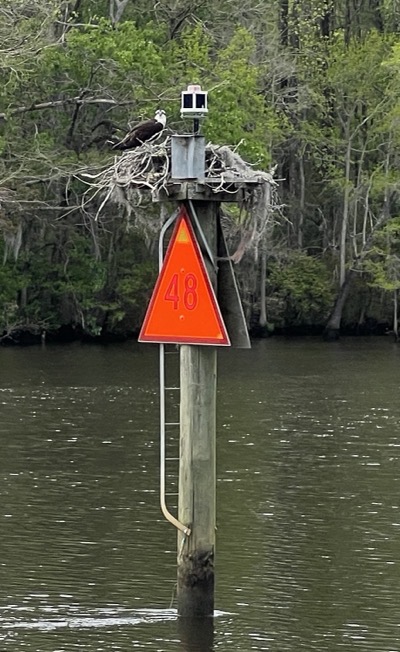
Osprey nests were common on channel markers in this part of the ICW, but not all of them were occupied. This one was.
We needed fuel and Capt John didn’t want to buy it at our overnight stop. I couldn’t blame him. At $5.04/gallon, the 150 or so gallons he wanted to put on would have cost a lot more than at two other marinas along the way. He chose Macca Wache Marina, which was pumping gas for $4.40/gallon. The only problem is that the marina closed at 4 PM and our late start put us in real danger of not getting there on time.
So Capt John made those two engines work a little harder and we cruised at closer to 8 mph for part of the trip. The fuel economy dropped. He wondered whether the extra fuel burn would cancel out any savings he might have for saving 64¢/gallon on 150+ gallons of gas.
We cruised through a few small settlements, each with their own No Wake zones, which we slowed down for. There were lots of little rivers and creeks from the mainland draining into the ICW along the way, but still not many boaters.
When it became obvious that we’d make it on time, he slowed back down. We passed by some fishermen and through an area that seemed to have a lot more signs of life along the shore. And then we were at Wacca Wache Marina. It was about 3:45 PM.
Fueling Up
Unlike a lot of medium to large cruising boats, Carver 36 takes marine gasoline instead of diesel. So after the dockhand helped tie us up at the diesel pumps, we had to cast off and reposition at a gas pump in a much more confined area. It never ceases to amaze me how Capt John can maneuver the boat in tight places without side thrusters, but having some experience with two engined houseboats, I know how the two drive systems can be used to control the boat’s steering and speed to put it where you want it to go.
While he and the dockhands filled the tanks, I headed off to the bathrooms. They were nice and looked pretty new, with glass door showers and modern fixtures. Beyond the building were the marina’s slips, which seemed to be accessible though only a narrow channel that I was glad we didn’t have to navigate. There was also a boat ramp, which got some use from a patio boat and a small, flat-bottomed fishing boat while we were there.
Another boat came in for gas just as we were prepping to leave. By that time, it was after four but the dockhands stayed on to help them. For a brief moment, I thought I might not get help casting us off, but then the guy who’d first helped us returned. Capt John backed out of the slip, turned in place, and headed back out into the ICW.
Wacca Wache to Osprey Marina
At this point, we were about two hours from Osprey Marina, our overnight stop. The area we drove through became pretty much deserted again, with trees growing out of the swamp on both sides of the channel. We were back to our normal cruising speed of 6 mph. Although the marina offices closed at 5 PM, I’d called ahead so they knew we were coming and had already told me where to park. There was no real rush since the sun wouldn’t set until after 7 PM.
It was an uneventful cruise. We sat up in the command bridge, watching the scenery go by. This far away from any inlet to the sea — the inlet behind us was past Georgetown and the inlet ahead of us was past North Myrtle Beach — the tide and current weren’t much of an issue. The water was smooth, for the most part, with only small ripples set into motion by the wind. Occasionally, the aroma of that beef stew would drift up to us. With an arrival at 6:30 per my Aqua Maps route, I told John I expected to be eating by 6:45. We’d pretty much skipped lunch.
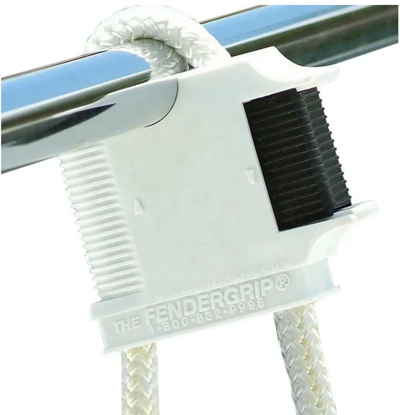
Capt John had some version of these: Fendergrip Push Button Fender Adjusters. I was not impressed with their performance. Devices like these need to work flawlessly and these did not.
Before we got to the turn, Capt John had me put out the port side fenders and adjust them higher. We’d been told that it wasn’t a floating dock; that meant the fenders had to be about as high as the gunwales. I struggled a bit with the fancy rope adjustment do-dads John had installed on each fender line; you squeeze to release and then the part you squeezed is suppose to spring back to secure the line at the new length. But each do-dad’s squeezing part was seizing, requiring me to pull on the squeezed part to try to get it out. I was dealing with this when we cruised slowly down the long channel that leads to the marina so I missed much of that part of the ride. Then, to really screw things up, we discovered that it was a floating dock after all and I had to lower all of the fenders again before we could park.
The parking place was along the fuel dock and it was tight. In fact, after we parked, we would be blocking several boats at nearby slips. Another transient boater at the other side of the fuel dock came over to help us when we came in. Between the three of us, we had Carver 36 tied up in no time.

Carver 36 parked at Osprey Marina the evening of our arrival. Yiu can see the long channel going out to the ICW behind the dock.
Connecting the power was a bit more challenging. The lines had to cross the stern, get handed out to the dock, and then get handed up to a higher platform above the fuel dock. Once again, Capt John’s splitter wouldn’t work in the 50 amp outlet — and once again, we’re pretty sure it was the outlet and not the splitter. So he plugged each 30 amp line into an outlet on either side of the power pedestal. This delayed dinner, but we were still eating by 7 PM.

Here’s my Aqua Maps report for April 2. We only traveled 29 miles.
Night at Osprey Marina
Capt John found our welcome bag, which contained a bunch of logo goodies and a jar of hot pepper jelly. It also included the all-important restroom key.

Osprey Marina Office on the evening of our arrival.
After each making a trip up to the building, we settled in for the night. It was crazy quiet and the water was like glass. I slept very well.
